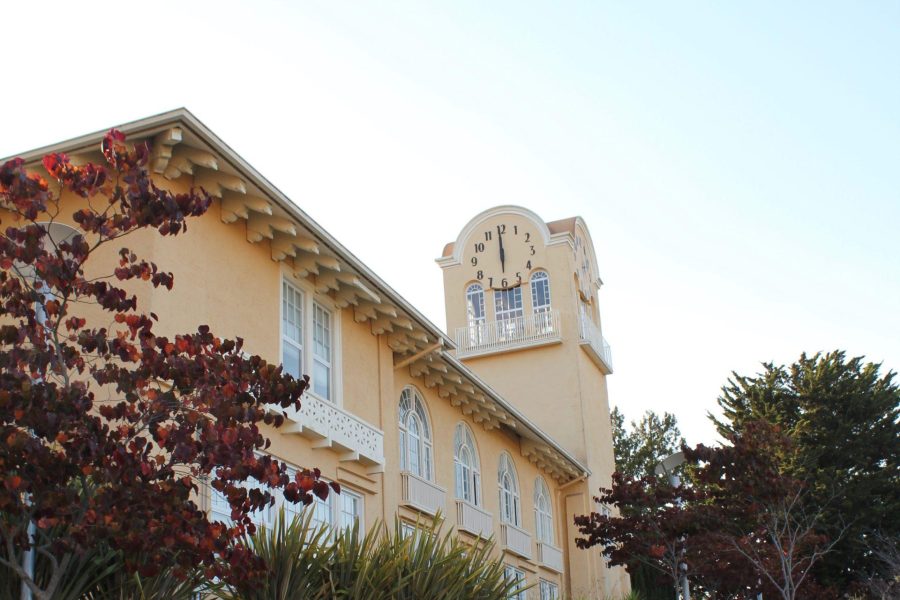Administration extends free lunch and breakfast policy
Jan 4, 2022
Last year, the Tamalpais Union High School District (TUHSD) implemented a free lunch and breakfast program at Tam following a state mandate to provide free lunch and breakfast throughout the pandemic. Going into this school year, California extended the free lunch and breakfast program throughout June of 2022, becoming the first state to do so.
“Prior to Covid, Tam was serving around 150 lunches, they had two employees. Now they’re serving over 850 lunches, plus breakfast, with three employees and we’ve been trying to get more employees since we’ve felt the need and staffing has been difficult so it’s harder,” Student Nutrition Director Lisa Herberg said. This has brought up a few issues with the serving lines and the amount of food provided. In a survey sent out over Parentsquare, many students expressed that the serving lines were too crowded, and moved very slowly.
“To accommodate the meals that we’re serving now, we really need one double line for every 100 students we feed. So we’re looking at 800-900 students, we really need 5 double speed lines,” Herberg said. This would be a larger project for the school to take on.
“This year they adjusted to make two lines inside instead of one, because it used to just be one. So right now we’re planning to continue with that, but if more students continued to use it then at that time [we would] make determinations. And that would be a pretty big redesign of the space just because they’re on different levels down there, the cafeteria side and the rest of the student center,” Assistant Principal Connor Snow said.
Students who responded to the survey were also discontent with the amount of food provided. Students who responded to an anonymous survey gave answers such as,
“The lines are very long, the serving size per student is way too small.”
“Not enough food for everyone”
“Not enough food”
“There isn’t enough pizza for everyone.”
“Schools are having supply chain issues with food, with the containers we’re putting the food in,” Herberg said. Funding for the program could potentially address some of the issues students expressed.
“The original funding came from the federal covid relief bills that got then distributed to the states, that the states distributed down to the districts to be able to provide free food for all students,” Snow said. For the time being, California has continued that funding. “During the pandemic, just because they knew there was much greater need than probably was being identified, it was part of the bill to provide that funding for free meals for all students. California is now extending that as the first state to take on funding free meals for all public school students,” Snow said.
“I’ve talked to alot of other school districts that have high low income people, that were serving high numbers, their numbers haven’t changed. So the funding that those school districts are taking in are the same, only some of the smaller school districts like Tam that have a low poverty rate are seeing a higher participation rate. So I believe that the funding won’t be too absorbent to make this happen, and as one person said, we’re giving students free touchpads to learn on, why aren’t we feeding all of our students?” Herberg said.
There have been many positive aspects of the serving lines as well. Many students were glad the free lunch program was implemented and would like it to continue.
“I was relieved I wouldn’t have to spend money at Safeway everyday,” senior and former member of the Tam News Linus Tornqvist said, adding, “I think it should have always been free.”
“The staff have been amazing, going from serving distance learning students in the parking lot in the rain and the cold all year last year and re thinking how they’re doing food. They packed food frozen or canned; they were no longer cooking food so that was different,” Herberg said. If the program continues, more funding would be needed to solve the issues that have been expressed. Many feel that this is worth it.
“When [Tam] came back 100 percent it was great to see the students. The students were happy to be back and I think that was the best part for our staff, to see students come back and to see smiles in their eyes … and that’s what keeps them going and working so hard to make those 900 meals a day,” Herberg said.
Herberg had suggestions for students regarding how they could be courteous to their peers during lunch. “We understand it, as food service people, but some of the sports students that need 3,000-4,000 calories want to take two of the hot entrees. So for the students at the end of the line, it leaves nothing for them so just be mindful about when you come in, take one hot meal, one entree, and then fill up on your calories with the salad, the fruit, the juice and the milk if you need those extra calories,” Herberg said.




